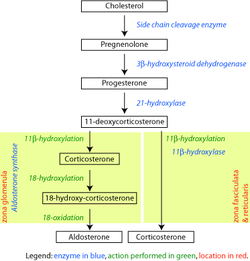21-Hydroxylase
21-Hydroxylase
21-Hydroxylase[edit]
Steroid 21-hydroxylase is an essential cytochrome P450 enzyme intricately involved in the biosynthesis of critical steroid hormones, namely aldosterone and cortisol. In humans, the genetic information for the synthesis of this enzyme is provided by the CYP21A2 gene.
Names and Classification[edit]
- Common Names: Steroid 21-monooxygenase, 21α-Hydroxylase.
- Alternate Name: 21β-Hydroxylase.
Function[edit]
Steroid 21-Hydroxylase belongs to the larger family of cytochrome P450 enzymes, a superfamily renowned for its role as monooxygenases. These enzymes participate in a variety of metabolic processes, including drug metabolism and the synthesis of vital molecules like cholesterol, steroids, and other lipids. Specifically, 21-Hydroxylase is found in the endoplasmic reticulum, where it hydroxylates steroids at the 21st carbon position. This enzymatic action is pivotal for the biosynthesis of steroid hormones, including cortisol and aldosterone.
Reaction Mechanism[edit]
21-Hydroxylase functions as a catalyst, facilitating the hydroxylation of the 21st carbon atom in steroid molecules, which translates to the addition of an "–OH" group. This modification is fundamental for the appropriate synthesis and function of certain hormones.
-
Steroid numbering - #21 is highlighted near center top.
Biosynthetic Pathway[edit]
The transformation catalyzed by 21-Hydroxylase is integral to several metabolic pathways, particularly those associated with steroid hormone synthesis.
 |
 |
Clinical Relevance[edit]
Deficiencies or anomalies in the CYP21A2 gene can lead to compromised 21-Hydroxylase synthesis, which in turn results in congenital adrenal hyperplasia due to 21-hydroxylase deficiency. This condition can have significant clinical repercussions. Additionally, a pseudogene closely related to the CYP21A2 gene exists. gene conversion events between this pseudogene and the functional gene are considered the root cause for many instances of 21-hydroxylase deficiency.
External Resources[edit]
- GeneReviews/NCBI/NIH/UW article on 21-Hydroxylase-Deficient Congenital Adrenal Hyperplasia
- OMIM database entry on 21-Hydroxylase-Deficient Congenital Adrenal Hyperplasia
- Graphical Representation of Desoxycorticosterone Synthesis from Progesterone via 21-Hydroxylase
- Steroid+21-Hydroxylase at the US National Library of Medicine Medical Subject Headings (MeSH)
|
|
|
This concise article on 21-Hydroxylase incorporates public domain text from the US National Library of Medicine.
| Metabolism: lipid metabolism – ketones/cholesterol synthesis enzymes/steroid metabolism | ||||||||||||||||
|---|---|---|---|---|---|---|---|---|---|---|---|---|---|---|---|---|
|
| Cytochromes, oxygenases: cytochrome P450 (Most belong to EC 1.14) | ||||||||||
|---|---|---|---|---|---|---|---|---|---|---|
|
| Oxidoreductases: dioxygenases, including steroid hydroxylases (EC 1.14) | ||||||||||
|---|---|---|---|---|---|---|---|---|---|---|
|
| Enzymes | ||||||||||
|---|---|---|---|---|---|---|---|---|---|---|
|
Ad. Transform your life with W8MD's Budget GLP-1 injections from $75


W8MD offers a medical weight loss program to lose weight in Philadelphia. Our physician-supervised medical weight loss provides:
- Weight loss injections in NYC (generic and brand names):
- Zepbound / Mounjaro, Wegovy / Ozempic, Saxenda
- Most insurances accepted or discounted self-pay rates. We will obtain insurance prior authorizations if needed.
- Generic GLP1 weight loss injections from $75 for the starting dose.
- Also offer prescription weight loss medications including Phentermine, Qsymia, Diethylpropion, Contrave etc.
NYC weight loss doctor appointmentsNYC weight loss doctor appointments
Start your NYC weight loss journey today at our NYC medical weight loss and Philadelphia medical weight loss clinics.
- Call 718-946-5500 to lose weight in NYC or for medical weight loss in Philadelphia 215-676-2334.
- Tags:NYC medical weight loss, Philadelphia lose weight Zepbound NYC, Budget GLP1 weight loss injections, Wegovy Philadelphia, Wegovy NYC, Philadelphia medical weight loss, Brookly weight loss and Wegovy NYC
|
WikiMD's Wellness Encyclopedia |
| Let Food Be Thy Medicine Medicine Thy Food - Hippocrates |
Medical Disclaimer: WikiMD is not a substitute for professional medical advice. The information on WikiMD is provided as an information resource only, may be incorrect, outdated or misleading, and is not to be used or relied on for any diagnostic or treatment purposes. Please consult your health care provider before making any healthcare decisions or for guidance about a specific medical condition. WikiMD expressly disclaims responsibility, and shall have no liability, for any damages, loss, injury, or liability whatsoever suffered as a result of your reliance on the information contained in this site. By visiting this site you agree to the foregoing terms and conditions, which may from time to time be changed or supplemented by WikiMD. If you do not agree to the foregoing terms and conditions, you should not enter or use this site. See full disclaimer.
Credits:Most images are courtesy of Wikimedia commons, and templates, categories Wikipedia, licensed under CC BY SA or similar.
Translate this page: - East Asian
中文,
日本,
한국어,
South Asian
हिन्दी,
தமிழ்,
తెలుగు,
Urdu,
ಕನ್ನಡ,
Southeast Asian
Indonesian,
Vietnamese,
Thai,
မြန်မာဘာသာ,
বাংলা
European
español,
Deutsch,
français,
Greek,
português do Brasil,
polski,
română,
русский,
Nederlands,
norsk,
svenska,
suomi,
Italian
Middle Eastern & African
عربى,
Turkish,
Persian,
Hebrew,
Afrikaans,
isiZulu,
Kiswahili,
Other
Bulgarian,
Hungarian,
Czech,
Swedish,
മലയാളം,
मराठी,
ਪੰਜਾਬੀ,
ગુજરાતી,
Portuguese,
Ukrainian





